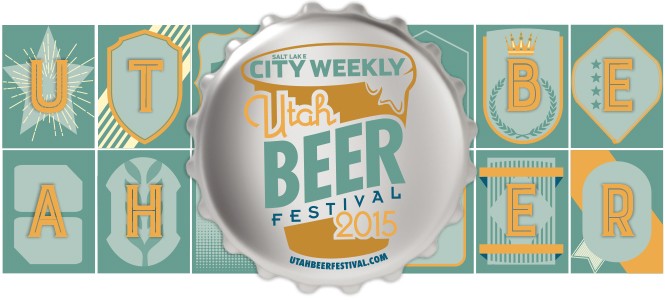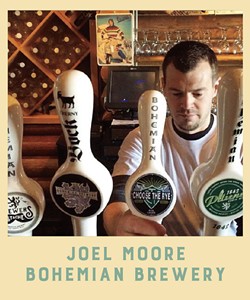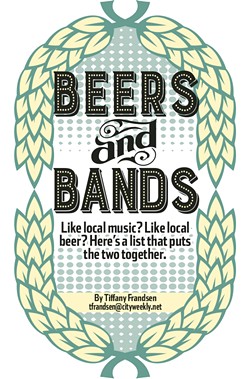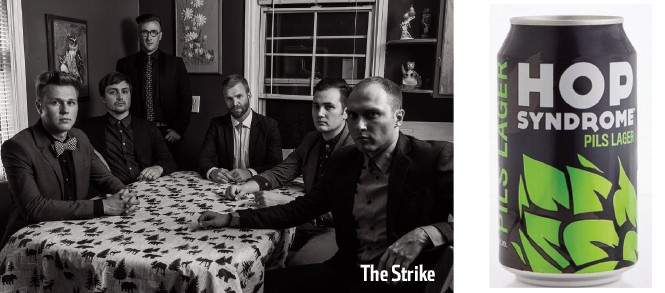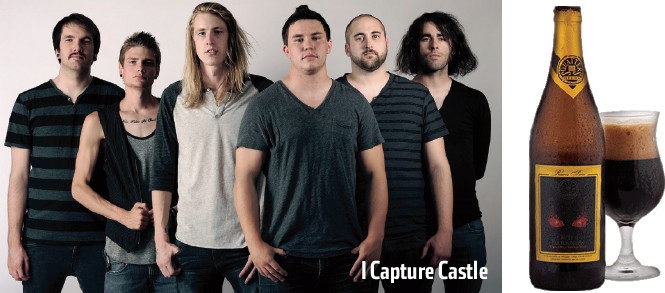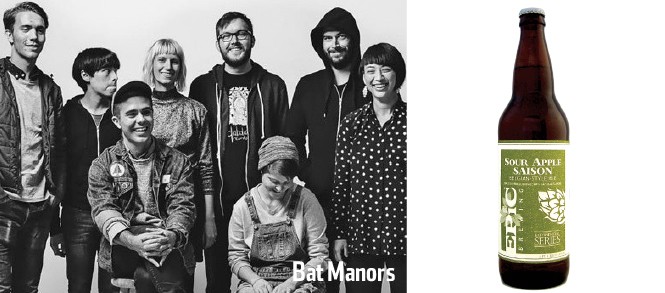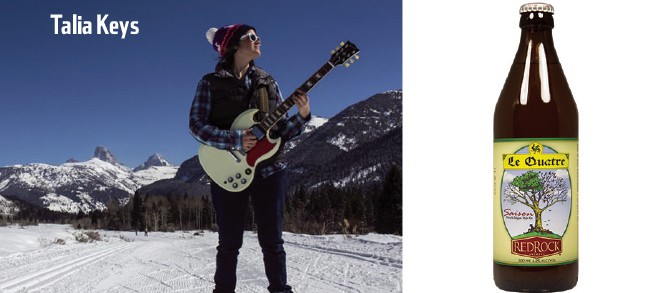Tickets: UtahBeerFestival.com
Utah Beer Festival 2015
City Weekly is now six years into its annual celebration of suds, aka the Utah Beer Festival. This year—on Saturday, Aug. 15, to be exact, from 3-8 p.m., at Library Square—the UBF hopes to attract some 6,000 beer aficionados, who'll have a chance to test and sample nearly 200 varieties of beers from 50 beer purveyors. They'll be able to nosh on food offerings, from pizza and burgers to curry and Korean barbecue, and they'll get their toes tapping to bands such as Whiskey Fish (3:30-4 p.m.), Folk Hogan (5-6 p.m.) and Afro Omega (6:30-7 p.m.). Tickets are $15 in advance ($25 at the gate), with a share of the proceeds going to support the Humane Society of Utah.
Those willing to plunk down a few extra shekels can hang out in the air-conditioned VIP Lounge at The Leonardo, where they'll acquire beer-tasting smarts from the Beer Professor, Bob Twewartha (see Five Spot, p. 8). The Salt Bistro, as The Leonardo's new in-house restaurant/caterer, will serve specialty foods to pair with beer. Meanwhile, Justin Godina, aka J Godina, this year's winning DJ in City Weekly's Best of Utah Music Awards, will get the groove started in the VIP Lounge for the first hour.
Want to make a memory of the beer fest? No need to settle on a blurry selfie: the Salt Lake Photo Collective will have a photo booth and will print souvenir photos for a mere $5.
Enough on the festival basics (just the visit UtahBeerFestival.com, for Pete's sake). In the following pages, you'll gather precious intel about the local beer industry itself. The City Weekly staff highlights how local brewers got into the craft, Utah Beer Blog's Mike Riedel weighs in on the latest trends he's noticed among local imbibers, and Tiffany Frandsen, City Weekly music writer and copy editor extraordinaire, has outlined places you can hop to—to forage for hops. She's even gone out on a limb attempting to pair beer with local bands.
All this is by way of saying: Enjoy the festival! That we're able to clink our glasses under the Utah sun just adds sweetness to every sip.
Living the Brews
It takes a daring man or woman to heed the call of professional beer brewing.
By City Weekly Staff
Among the typical career aspirations for high school graduates—teacher, engineer, doctor, nurse—beer brewer does not rank highly.
Few kids grow up fantasizing that one day, they might be able to brew beer for a living. There are no merit badges in beer-brewing. Few Utah high-school guidance counselors laud beer brewing as a promising career path.
Only a handful of professional brewing programs are even offered in the United States, and they provide only certificates or diplomas after completing weeks and occasionally months of intensive studies.
As such, many brewers land in the mash quite by accident, and often later in life. Some learn to brew literally on the job. Others are home-brewers who want to turn their hobby into a day job.
The good news is, with the popularity of craft brewing exploding, Utah is riding the wave of that growth. Currently, there are 21 breweries in Utah, with six soon to open. Brewmasters can even earn a living for their long hours and hard work: The Brewers Association Benchmarking and Best Practices Survey ranged 2012 salaries for brew masters at between $45,000 and $50,000/year.
Despite the good news on the industry side, beer brewing will likely remain an under-the-radar occupation in Utah, given the anti-alcohol message drilled into Utah students' heads during high school and even in college—to say nothing of the fact that a fair number of young'uns won't ever imbibe the stuff, period. Something to do with their religion.
It begs the question: What was it, then, that flipped the switch for those who do brew beer for a living? That's what we asked a representative sample of brewers in our community, and their answers are as varied as the colorful taps festooning any bar.
When did you realize you could brew beer for a living?
Donovan C. Steele (Hoppers Grill & Brewing Co.): I became interested in and obsessed with brewing while at the University of Utah studying anthropology. I knew afterward that I would either go into a culinary field of study or find a way to brew beer for a living, or at least a serious hobby. I've always had to figure out how things work, break the components down and build them back up, then try to make stuff from scratch. Beer was a significant challenge: I had to discover how it was made, what made it good and then what made it better. In 2003, just a few years after graduating, I was approached by Tim Barr, then-brew master of Hoppers, to work as the brewer for Ruby River Brewery in Riverdale. I brewed there until 2007.
Dave Watson (Bonneville Brewery): My first brewing job was in a small pub in New Mexico. I was working there as a bartender while I finished college and had just started home brewing with the mad fever of an obsessed beer nerd when one of the shift brewers left. They were nice enough to give me a shot in the brewery. At first, it was just a part-time gig. It wasn't until I moved to Utah that I realized this might be what I did when I grew up. And you know what? It still might. I'll let you know.
Trent Fargher (Shades of Pale): As a home brewer, when I was sharing beer with friends, the feedback would be, "You should sell this." This, however, is always the case with friends who are getting free beer that is drinkable. I would brush this off—it was a fun hobby and not a big deal. After years of messing around and sharing more, the message [became]: "This is really good; I would buy this." That got me thinking and looking more into what it would take to start brewing on a full-time basis.
Jeremy Baxter (Zion Canyon Brewing): I started home brewing, like many a brewer. [After] the fourth or fifth batch of beer in my kitchen, I thought, "Oh my God, people do this for a living?" I learned really quickly I wanted to create my own flavors and touched base with a brewer in Telluride, where I was living then. He got me a little grain, sold me 5 gallons for ingredients. I told him: "If you ever have a slow time, I'd love to learn how this works on this scale." He offered me a job and I worked there from 2007-'09. I moved to Utah in 2010 and joined this brewery in 2013.
Jordan Schupbach (Epic Brewing): When I was in college in Canada, I started home brewing. We started making it because we were poor, but it's a hobby that most people, once they start, get pretty obsessed with. I finished college, and I was living in Portland, Ore., and I couldn't find a job using my degree, so brewing was in the back of my mind. It was one of those things; if you're going to do what you want to do, do what you love—especially being in Portland, which is a big beer town anyway. I decided to start applying for brewing jobs there, and still didn't really have any luck. That's when I decided to go to brew school.
Where did you get your training?
Steele: I studied home-brewing books, the style and history of brewing and traditional brewing methods. Professionally, I was extremely fortunate to learn brewing skills and knowledge on the job from Kevin Ely, currently Uinta's brew master, who had taken over for Tim Barr soon after I was hired. Since becoming the brew master of Hoppers in 2007, I've continued personal study and taken professional courses from the Seibel Institute of Technology and Doemens' World Brewing Academy. Fortunately, I had a professor who was a retired production and technical director from South African Breweries by the name of Terry Harris, and through his mentorship and correspondence I was able to dial in my lager fermentation profiles, which I've had great success with lately.
Watson: I first got my feet wet (literally) at High Desert in Las Cruces. My first brewery job in Utah was assisting Chris Haas at Desert Edge Brewery. I learned a ton from Haas. Without that experience, I wouldn't be where I am now.
Fargher: Nothing glamorous on the training: It came through trial and error, books, the Web, forums, talking with other brewers and wherever I could find information. School of hard knocks.
Schupbach: It was the Master Brewers Program at University of California, Davis.
What were you doing prior to this profession?
Steele: I was working at Art's Brewing Supplies (642 S. Washington St., Salt Lake City, 801-533-8029, ArtsBrewingSupplies.com) for a couple years after graduation from the U of U. It was at Art's that I became familiar with all the malted grains, hops and yeast strains. I also came to know Tim Barr; he would frequently purchase grain.
Watson: I was a photojournalist. I worked for a newspaper in the Four Corners region. I have a bad habit of turning hobbies into jobs.
Fargher: Most recently, I was doing information technology consulting on Oracle Software products. Prior to that, I was doing accounting, bookkeeping and taxes ... basically, learning how to run and operate a business.
Baxter: I've been all over the place. I've worked in grocery stores, cleaned homes, shuttled vehicles and shoveled snow. We did what it took to pay bills while we kept looking for what we wanted to do. And in brewing, I found it.
Schupbach: I majored in biology. My focus was on plants. I wanted to do basic research.
What do you like most and least about brewing?
Steele: Mostly, the actual process of product design and then brewing the beer: grain, hop and yeast selection, formulating the recipes, executing the fermentation plan and subsequent conditioning—it's very satisfying to go from concept or idea of what a beer should taste like, to putting together the right ingredients and finally, after weeks or many months later, ending up with a successful beer in hand. All aspects need careful attention for quality control and a good product. What I like doing the least is the almost constant but absolutely required cleaning of the brew house. But, I find the results rewarding and satisfying when everything looks polished and clean.
Watson: It's a fascinating process. There are tons of cool parts, but probably my favorite moment in the process of wort production is when the beautiful liquid is first separated from the grain (called lautering). It's a magical moment I compare to the moment a photograph first begins to develop in the darkroom, if anybody remembers those.
Fargher: It is probably the equipment aspect in building a functioning brew house that I like the best. I also enjoy talking with people outside the brew house about the products that we create. I love seeing that smile on somebody's face when they try the beer for the first time, and aren't disappointed. What do I like least? Janitorial duties. They are the necessary evil to keeping the beer good.
Baxter: I love the smell when you mash it, getting that aroma from the mash. I love the creativity involved going toward a style that in all likelihood is the first time it was ever made. I love tasting it, tasting other examples and flavors; I love the whole process. What I like the least? It gets pretty humid in some stages of the process—it's almost uncomfortable. It's really good for your skin; it's like working in the sauna. The challenges of mechanical issues that arise can be stressful but keep you engaged.
Schupbach: It's fun making the beer, creating the recipes and seeing something take the baby steps toward something really good. But it's pretty hard labor. Once the wheels are turning, you can't stop the process, so it can be a bit stressful. ... When you have brands that you distribute to 18 different states, we don't necessarily brew everything we want to all the time. My least favorite thing is that my job becomes more and more administrative as we grow. As I move up in the ranks, probably 75 percent of my time now is at a computer. I've been here for three years. I'm no longer a shift-brewer. Those are the guys in the trenches, doing all the hard work, but it's the fun work of mashing in and creating. I'm managing the brewers and making sure everything's getting done.
What sets your beer apart from others, and what do you want to be known for?
Steele: Making great beers from a very small brewpub by using high-quality specialty malted barleys and grains for all of our beers. I think I'd be known for making creative and flavorful lagers that are balanced in flavor and aroma, clean-tasting and well-designed. Lagers are exciting and should taste complex and refreshing, inviting the consumer to have another.
Watson: About 35 miles. All I want to do is consistently produce quality beers people love to drink.
Fargher: I believe in passion and doing what you love. I believe in hard work, in excellence and creativity. The expression of what I believe is in the beer. The passion is in the bottle, my joy is in sharing it. That is what sets my beer apart: a dream, hard work and creativity. I think you will taste the difference. I want to be known as someone who made the world a better place. Not too big of a goal.
Baxter: They have a unique flavor. Different regions create different beers with their water source. We have a unique water source with the Virgin River coming through [Zion National Park]. I try to mimic styles I personally find amazing, but they're always unique. You do the best with what you've got, and everything's going to work out. I want to be known for being damned good at what I do.
Schupbach: The variety of beers that we have. If you come to the retail store on State Street, it almost looks like it's an aisle you'd find at a craft-beer store because we produce 40 brands. We did a lot of work to make sure those beers are distinct: ... We use different yeast strains that give the flavor profiles, three different base malts that can have a large impact on the overall flavor of the beer; we have a ton of specialty malts that give the beers the body, colors, flavors; we contract so many different hops that it's almost overwhelming. On top of that, we change our water chemistry to match the water chemistry that will be better suited to different styles. If we make a beer that's a pilsner, we try to match the chemistry to water that would come out of Plzen, Czech or Germany—they have very soft water.
What would you tell someone who wants to become a brewer?
Steele: Go talk to local brewers about what the job is like. Ask them what they like and don't like. There is this misconception that working in a brewery will be days filled with designing recipes, tasting beers and smelling hops. Even for a head brewer responsible for formulation, it's a small amount of our time. In reality, it's a lot of cleaning, heavy lifting, troubleshooting and monitoring of operations. If they're still interested, they should take classes in science, electrical/HVAC, biology, arts, culinary training, research and problem solving, behavioral science, management, accounting, brewing classes in fermentation and quality control/quality assurance. We do a little bit of everything. Most brewers coming into the industry have or are getting BA or BS degrees and/or brewing-science-specific diplomas. Then they should get involved in the local brewing community.
Watson: Read everything you can find, practice a lot and learn to love cleaning. One major difference between home brewing and commercial brewing is there is a lot more time management involved. Things that take 10 seconds at home might take 30 minutes in the brewery. Practice staying focused and streamlining as much as you can.
Fargher: Run, Forrest, run! Expect long hours, low wages and nothing glamorous. If you want the exact opposite, go into sales.
Baxter: I would say start brewing. Go to your local brew shop and buy a kit, and get after it and follow the cleaning instructions. Don't skimp on the cleaning. Don't give up. If the beer doesn't seem like it's correct, then wait. It takes experience to learn how much beer changes through its fermentation. It's no different from any manufacturing. Have a real positive attitude and openness to constructive criticism—and an ability to listen.
Schupbach: There are two routes: The one I took, go to school and dive headfirst, but I would recommend people going and getting an entry-level position at a brewery. It might take a bit of time, if you are trying to do it in your hometown, but just go and get on the packaging crew and move your way up. I've seen a lot of the brewers here at Epic—they started on the packaging crew and then worked their way up the brew house. It's good for people to get a feel of what the work actually is, because it's a job that gets put up on a pedestal—seems so cool, brewing beer is so amazing, but it's a lot of work.
Donovan C. Steele is brewmaster at Hoppers Grill & Brewing Co. (890 Fort Union Blvd., Midvale, 801-566-0424, HoppersBrewPub.com). Of Steele, Utah Beer Blog's Mike Riedel writes, "Donovan Steele is one of the great innovators of beer in the area. If you haven't been by Hoppers in a while, you've probably missed out on some great old world beer styles that have hardly been seen or tasted in North America. From Patersbier-styled Belgian ales, to Polish Grodziskies and even French style Bier de Gardes; this boy likes variety in his brew house." (Bill Frost)
Dave Watson is head brewer at Bonneville Brewery (1641 N. Main, Tooele, 435-248-0646, BonnevilleBrewery.com). Watson was born in Los Alamos, N.M., near Los Alamos National Laboratory, home of the atomic bomb. He enjoys spending his spare time with his 14-month-old daughter. "I also like tinkering with electronics and building things in my basement," Watson says. "I'm good at coming up with really overcomplicated solutions to simple problems. When I can, I like to travel." (Brandon Burt)
Trent Fargher After operating in Park City for the past four years, Shades of Pale (2160 S. West Temple, 435-200-3009, ShadesOfPale.com) relocated to South Salt Lake—just south of downtown (right next to the Trax Center Point Station). Currently producing five year-round four percent ABV beers in either 12-ounce or 22-ounce bottles in on- and off-premise stores, Shades of Pale is also producing experimental high- and low-point beers. Shades of Pale is slated to open its Brewery Tap Room in August. Plans include an outside seating area and will partner with several other vendors for food. (Derek Edwards)
Jeremy Baxter hails from eastern Idaho and now serves as head brewer at Zion Canyon Brewing (2400 Zion Park Blvd., Springdale, 435-772-0404, ZionBrewery.com) in Springdale, Utah. "Production has increased a lot recently, he says. "What we produced up until the end of May this year was the same amount as we made for all last year. It's a fantastic location for a brew pub [next to the Springdale entrance to Zion National Park]." (Stephen Dark)
Jordan Schupbach has been the head brewer at Epic Brewing Co. (825 S. State, 801-906-0123, EpicBrewing.com) for the past three years. He went to college in Canada, where he started home brewing, and then moved to Portland. While on the waitlist for brew school, he spent a winter ski-bumming in Salt Lake City, which led to his career at Epic Brewing. (Tiffany Frandsen)
Brian Coleman
2-Row Brewing
After years of honing his skills as a home brewer, racking up awards for his brews and broadening his beer smarts by taking college courses on the subject, Brian Coleman, co-owner and brewer at 2-Row Brewing, decided that he could pull off being a professional brewer.
"I just found I had a huge passion for it and, as I continued to brew and continued to improve, I noticed I had kind of a large following of friends that was waiting for the next batch," Coleman says.
So Coleman waded into the time-consuming task of opening a real brewery—a process that he says distilled into reality when a 3-barrel (93-gallon) brew house in Georgia became available. "It was one of those big 'aha' moments that said, 'This was your time,'" he says.
For the past month, Coleman and his wife, DeDe, who also co-owns the brewery, have been brewing up four beer styles at their brewery in Midvale. The beers, a pair of hoppy India pale ales, a 9-percent alcohol Saison called "Dangereux"—because of the long list of escapades its devotees experience when imbibing—and a golden ale.
The beers are all above the 4-percent alcohol limit allowable for draft beer in Utah, so Coleman has gone the packaging route, putting his beer in bottles. Though no tasting is presently allowed at the 2-Row brewery, bottles can be purchased there. 2-Row's wares can also be found in restaurants and bars, including the "three Bs," as Coleman calls them: the Beerhive, Bayou and Beer Bar.
Coleman, who also owns a towing company with DeDe, says he's enjoyed the transition from home brewer to professional brewer. At home, he says his goals were to simply make beer. Now, after taking courses in quality control from Oregon State University, Coleman says he enjoys the microbiology side of the beer-making game, monitoring fermentations, tabulating the volume of yeast cells and ensuring that the beers are consistent, and consistently good.
"There's just nothing better than coming into the brew house early in the morning, cranking the tunes up and mashing in," he says. (Colby Frazier)
2-Row Brewing
6856 S. 300 West
Midvale
801-987-8663
2RowBrewing.com
Joel Moore
Bohemian Brewery
The brew alchemists at Bohemian Brewery are proud adherents to "continental" beer, that brand of brewing that covers German- and Czech-style brewing. The Germans and Czechs seem to know a thing or two about beer, and Bohemian brewmaster Joel Moore says it's a proud tradition they follow.
The brewery's lagers, especially, hearken back to the German invention of "lager" in general, a special beer that, more than a century ago, was stored in caves packed with ice and snow during the summer months, where it developed a crisp, clean finish (lager translates to "storage," as in the cold storage of the beers). While technology has improved from caves and ice, these old-school principles are still very much alive at Bohemian Brewery.
"That's definitely the basis of our brewing philosophy," Moore says, "Trying to stick to the tradition of those brewers."
Moore himself got into the game over a decade ago at a brewpub in Nebraska, where he worked his way up from a busser to assistant to the brewmaster. He studied brewing at the Siebel Institute of Technology in Chicago, and later in Munich, Germany.
In 2012, he joined with Brian Erickson to head up brewing for Bohemian. Since then, the brewery has gone from four beers on tap to 10. In 2014, Moore says the brewery produced 4,200 barrels (one barrel is 31 gallons), a 30-percent increase from the year prior, and this year, the brewery is on track to produce 4,800 barrels.
Moore is especially proud of a of a limited-edition brew called The Perfect Gentleman Helles lager, made out of 100-percent sterling hops, crafted in homage to Sterling Archer of the Adult Swim cartoon Archer. The helles is light and hoppy, in contrast to other on-tap favorites, such as the brewery's Dunkelweiss, a dark German wheat beer with distinct bready, caramel notes.
Moore is also proud of the Hefeweizen he helped develop for the brewery—again, because it pays homage to the continental traditions; this Bavarian-style Hefeweizen is heavier and less fruity than Americanized hefs.
"I'm definitely of the opinion that [brewing is] a little bit more science, but I understand the subjective nature of people's palates," Moore says. "There is a certain subjective aspect of what you're building and creating—but it's based on principles that you must follow, and they are scientific in nature." (Eric S. Peterson)
Bohemian Brewery & Grill
94 E. 7200 South
Midvale
801-566-5474
BohemianBrewery.com
FutureCraft
What we want to see more of (and less of) in Utah craft beers.
By Mike Riedel
Over the past 2 1/2 decades, I've spent more than a good amount of my free time geeking on, and learning about, all aspects of beer. But it's been in the past 10 years that the majority of good (and bad) of craft beer has caught on in Utah's popular culture.
Today, there are 21 different breweries of various sizes around the state—with more coming. The selection of out-of-state and import brands is exploding as well. With such consumer overload, it can be tough to identify what beer trends in Utah are truly working in the best interests of beer drinkers.
So, as I sit here on my barstool, chatting with and gazing out upon all of you happy beer drinkers, I've gathered a good sense of what you're loving and disliking about Utah's new craft-beer explosion.
Let's start with some of the less desirable trends:
LESS OF THIS
Stupid Gimmicks
I get it: In a super-competitive beer world, you need to try to set yourselves apart from the other guys. But, beer made from the yeast found in a brewer's beard? Beers packaged in the carcasses of dead squirrels? Barrel-aged Tabasco beer? I know our attention spans are getting shorter and shorter, and we need more stimuli to get keep those neurons zapping, but WTF, people?!
Is it Beer or Booze?
This could also fall into the "gimmick" category, but it's becoming prevalent enough that it deserves its own discussion. Beer is beer because it's fermented grain. Let whatever super-yeast that exists out there do its job to the best of its ability, and we can still call it beer. But when you artificially cold-distill these beers into monstrous rocket fuel, then we should probably give these creations a new classification. Yeah, beverages like Brewmeister Brewing Co.'s Snake Venom Ale—which dials in at 67.5 percent ABV (135 proof)—is still technically beer—but then again, whiskey in its most base form is also beer. These are just outrageously expensive malt-based liquors.
Trophy Beers
I've got beers in my cellar that are so rare that the mere act of owning them brings me high status in the craft-beer community. If I drink them, I lose my ownership in them. If I don't drink them, they'll just turn into soy sauce or cheese. You already spent the money: Enjoy the damned things! That's why we have them.
Beer Snobs
I used to be one—but I'm not anymore. When you surround yourselves with beer geeks, the mob mentality toward less fizzy yellow beers rub off on the average beer drinker, whose level of self-importance could make the Algonquin Round Table look like Granny's bingo parlour. This past June, I actually witnessed some ass spit his beer into the face of an innocent server. Dial it back, beer snobs. You, too, can find joy in a PBR. I have.
OK, the tough part is over for me. Those things we should be doing less of locally are often few and far between. The things we should be concentrating more on as a beer community are far more constructive.
MORE OF THIS
Boozy Beers in Smaller Packaging
Right now, I'm looking at a delicious beer that I'd love to drink. I have the shekels in my pocket and the desire in my heart. The problem is that it's a 750-milliliter bottle of 13 percent ABV beer. If this beer were in a 12-ounce bottle or smaller, my tongue would be molesting it right now. Give the consumer the ability to administer his or her own dosage when it comes to packaging, and we'll all be happier. Thankfully, some breweries are taking notice. Squatters' Outer Darkness Imperial Stout is available not only in 22-ounce bottles but also in a more manageable 7-ounce bottle. That's the perfect size for a 10.5 percent ABV beer.
More Nitro Options
Not only are nitrogen-conditioned beers beautiful to look at with their cascading bubbles—falling instead of rising—they are also different on the tongue. They provide a creamy texture while adding elements that appear sweeter compared to carbon-dioxide-conditioned beers. Avenues Proper's Oatmeal Red Ale and The Annex's Single Hop Golden Ale are fine examples of nitro beers.
Ciders & Meads
When you're "all beer'd out" and need something different, it would be nice if we had more options from beer's close cousins: ciders and meads. The flavor profiles of The Hive Winery's Stinger Hard Cider and Citrus Blossom Mead are much different from beer and are often enhanced with spices and fruit. Plus, they're the perfect option for the gluten-free crowd.
Social Media
I've met many close friends through beer social media. No matter their politics or beliefs, we always find common ground over a pint. One I enjoy is Untappd, a unique social drinking app that allows beer lovers to find what beers are nearby and to show what your friends are enjoying. Beer Buddy accesses the massive beer database from RateBeer.com, allowing users to not only rate beers but participate in discussions. Apps like these go a long way to making a night out more social.
Sour and Tart Beers
Once upon a time, I had no use for funky sour beers; now I crave them all the time, and I'm not alone. Home brewers and breweries are expanding their portfolios to meet the increasing demand. To get into the proper frame of mind for a sour beer, you need to have more of a wine mentality. Only then will your mind be more accepting of the tart and sometimes fruity flavors. RedRock's Paardebloem Dandelion Ale, Wasatch's Switch Wild Ale & Uinta's Birthday Suit Sour Ale are all about big puckering/sour-puss enjoyment.
Beer Politics
Let's be honest: We beer lovers know we have unique challenges in Utah. If you want change, participate in the political process. Many of us are tired of the way the state controls alcohol, so get involved! Everybody sitting with me at this bar is fed up with the 3.2-percent-only beers on tap. It's not enough to be pissed off. Look to the guy or gal in the mirror, and start hammering away at your state representatives to bring Utah into the 21st century. CW
Mike Riedel is a craft-beer connoisseur/advocate who scribes on a regular basis at Utah Beer Blog (UtahBeer.blogspot.com).
Park City's mining boom in the 1880s also brought with it hops. Immigrants from Germany brought the rhizome plant to Summit County where they came to mine for silver and needed a taste of home after a long day's work. Now, hops sprout throughout the county. Some are as easy to find as knowing which trails to walk down, while others take a degree of foraging.
June through August, Summit Land Conservancy—a nonprofit that protects open-space land, animal habitats, watersheds and other environmentally sensitive areas—hosts twice-monthly hikes giving opportunities to harvest wild hops. Its brewing partner is Wasatch Brewery, which uses the hops for Summit Land Conservancy's annual fund-raising beer: Clothing Hoptional.
Since the hops grow wild, the taste of the final product is unpredictable. Although the conservancy group checks on the hops before harvesting, it leaves the growing part up to nature—nobody is supplementing water or trellising the plants. The spongy, green cones grow from the rhizome root, which self-propagates underground and grows well in most soil, with lots of sun and water. They are tough and resilient, so they do just fine in Utah's climate. Even if exposed portions of a plant die during a brutal winter, the rhizome sprouts anew the following spring.
This means that the chances of getting a wild crop are high, but the varieties of hops harvested is a game of roulette. Hikers don't necessarily know which varieties they have discovered. As such, beer drinkers may be surprised by how varied Clothing Hoptional beer tastes from year to year.
Several patches of wild hops are surprisingly urban, growing in pockets of open-space land in and around Park City. Wild hops can be found on the edge of the pavement on trails along Deer Valley Drive, the Historic Union Pacific Rail Trail—just a 20-minute walk from Main Street in Park City (the bulk of which volunteers harvested in late July)—and along Daly Avenue and other roads.These ripen near the end of the hiking season, and so far, the volunteers have hop-hunted at McPolin Farmlands, the Virginia Mining Claims (in Old Town) and both Empire and Daly Canyons.
The conservancy monitors and harvests wild hops that grow on private lands, which are preserved through conservation easements. The contracts create an agreement so that land-owners can do mostly what they'd like with the land, as long as they follow the agreed-upon preservation limitations (for example, as long as they don't build condos or tennis courts). Easements typically don't expire, so the land is protected even if the ownership changes.
The Summit Land Conservancy hikes are free and open to the public. While the primary focus is hop-hunting, the group also talks about other local plants that grow around the trails, as well as what parts of plants are edible (volunteers are encouraged to bring snacks anyway). The last Summit Land Conservancy-sponsored hike of the season is Aug. 16, at Prospect Ridge in Park City. More details on the hikes, harvesting and brewing are available at WeSaveLand.org.
Desert Edge Brewery uses local wild hops in one of its brews, Radius. Radius is a light, filtered seasonal ale featuring wild hops harvested within a 180-mile radius of Desert Edge's Trolley Square location.
Hops can also be found in Salt Lake City—Bohemian Brewery grows hops on trellises alongside the rear of the restaurant and surrounding the parking lot. In late summer months, the leafy vines emit an aromatic smell; those little bulbs that look like green pine cones are hops, and they aren't long from being harvested and brewed into strong beers. For its rare wet-hopped American red ale Wetter Off Red, Avenues Proper gets hops from a friend who grows them in Salt Lake City.
It's not just breweries that grow hops. Vertical Diner, a midtown vegetarian and vegan café, includes hops in its on-site garden among the kale and fennel. Red Butte Garden also has a hop vine not far from the entrance to the amphitheater where concerts are held.
Home-brewers grow hops in their backyards, on fences, trellises, patios, etc.—all it takes is planting a rhizome root in fertilized soil.
Of course, for those who prefer the capriciousness of wild hops—both in foraging and in the taste of their beer—not all the wild hops are on the map. It may be challenging to discover new sources of those bitter little cones, but it is a worthwhile challenge. Hop on it. CW
Like any great romance, Utah's love affair with beer can only be enhanced by a great soundtrack. Adjectives used to describe the complexities of beer are often similar to those used to describe the complexities of music—so why not link them up? Test drive this list of unique artists and beers of Utah and then get on CityWeekly.net to suggest your favorite pairings.
The Beer: Uinta's Dubhe Imperial Black IPA—9.2 percent ABV
The Taste:Strong and dark
The Band: Atheist
Atheist's—aka Scott Knofp—raps are as hard-hitting and strong as his beats. Sure, he can be dark (check out "Warriors"), but really, his clever wordplay and subject matter keep his tracks amusing and entertaining. As his chosen street name would suggest, he tackles the topic of religion in a state that is hotboxed by it. And the darkness doesn't mean he isn't funny; in fact, some raps are passionate rants about the Teenage Ninja Turtles, and witty stories about parties in the Salt Lake City Avenues (spoiler, here's the story: The cops show up and tell partygoers to turn down the noise. The partygoers agree. The cops leave. That's really it.). His shows are intense and face-shaking, and damn, can he freestyle.
The Beer: Uinta's Wyld Extra Pale Ale—4 percent ABV
The Taste: The singer/songwriter of beers, it pairs well with meats and cheese without stealing attention.
The Band: John Louviere
John Louviere's acoustic folk set provides a great ambience with poetic, poignant and emotional lyrics. Lake the ideal background music playing during an evenng out with a beau, he's subtle and won't steal attention. Even though he's a talented guitar-player, the emphasis is on the lyrics; those guitar chords are laying an emotional tone that complements the story. His self-released debut, Longest Year, covers a range of man-and-guitar music. Some tracks, such as "Transplant" and "Turned Out Like You," are heart-wrenching and mellow, while others are punchy folk, such as the upbeat chorus of "Longest Year."
The Beer: Epic Brewing's Pils Lager: Hops Syndrome—4.5 percent ABV
The Taste: Crisp, hoppy, refreshing and tastes a little like tart candy.
The Band: The Strike
This band, like the beer, is not what one might expect (with a name like Hops Syndrome, you'd think it would be hoppier—but the bitterness is very subtle). This dashing group of eight suited-up Provo dudes play pop-soul in energetic, funky, jazzy fashion. Lead singer Chris Cabb is a charming and charismatic combination of Michael Bublé and Justin Timberlake (the R&B years), backed by a three-piece brass section and talented guitarists, bassist and drummer.
The Beer: Squatter's Outer Darkness
—10.5 percent ABV
The Taste: Smoky and a little rough. If you're looking for dark, here it is.
The Band: I Capture Castle
A heavy, growling Salt Lake City hardcore metal band, I Capture Castle is doing something relatively new in the metal genre: electronics. This band is basically the musical equivalent of steampunk. The darkness of both the sound and the lyrics is still heavy, and lead singer Marcus Gressman's voice is gruff and gritty. Their newest EP, Daydreamers, is altogether frenzied, agitated and vigorous. For further proof that this group of heathens is not the stereotypical metal band, check out their growly cover of Ke$ha's "Take It Off."
The Beer: Bohemian Brewery's Cherny Bock Schwarzbier—4 percent ABV
The Taste:A little chocolately, a little coffee-tasting.
The Band: DJ Battleship
This guy is an absolute monster on the steel wheels. That coffee taste in the beer, in this case, creates that fine feeling from drinking joe, a feeling similar to the one I get listening to DJ Battleship. His spinning is frenzied—his quick hands— are impossible to follow—and he mixes both dark rap roots and '90s rap classics like "Jump Around" from House of Pain with lots of erky-erky-erky-whop! vinyl-scratching.
The Beer: Epic Brewing's Sour Apple Saison, Belgian-style Ale
—8.1 percent ABV
The Taste: Pale gold, with crisp, sour-apple tartness.
The Band: Bat Manors
Bat Manors are calm, summery and more complex than they look. The indie-folk band uses a variety of instruments—including the standard indie-band setup, plus keys, two violins, viola, cello, flute, clarinet, glockenspiel and trumpet. There is a lot of sadness—along with some comfort and hope—in the sound and lyrics of their debut album, Literally Weird (Bleed101 Records). It's beautiful, with atmospheric, flowing harmonies.
The Beer: Red Rock Brewing Company's Le Quatre Saison Belgian-style Ale—6.2 percent ABV
The Taste: Light, moderately hopped, with a hint of tartness.
The Band: Talia Keys
Talia Keys' version of blues music is infused with beatboxing, which she does herself (that's right, Adam's apples aren't required to box the beat). Deep down in her bluesy tracks is this hippity-hop reggae beat and sensibility in her songs. Her voice is slightly raspy, but she has tremendous control over the timbre and the rasp sometimes fades into an edge.
More by City Weekly Staff
-
THE ESSENTIAL A&E PICKS FOR APR 18 - 24
Ririe-Woodbury: Ascent, Tumbleweeds Film Festival, Look at Us: Portraits of Endangered Species, and more.
- Apr 17, 2024
-
MUSIC PICKS APR 18 - 24
INZO @ The Complex 4/19, Page Fish, Kaytlin Numbers @ Velour 4/19, Fuck Mike Lee Fest @ The Beehive 4/20, and more.
- Apr 17, 2024
-
MUSIC PICKS APR 11 - 17
Direct from Sweden - Music of ABBA @ Abravanel Hall 4/12-13, BYNX @ Soundwell 4/13, Talib Kweli @ Urban Lounge 4/15, and more.
- Apr 10, 2024
- More »
Latest in Cover Story
Readers also liked…
-
Forget the family pedigree—Robert F. Kennedy Jr should not be the next president of the United States
Trojan Horse
- Jun 21, 2023
-
Women decry harassment and toxic culture at St. George auto dealership
Men at Work
- Oct 11, 2023


